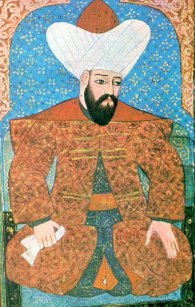Related Research Articles

Orhan Ghazi was the second bey of the Ottoman Beylik from 1323/4 to 1362. He was born in Söğüt, as the son of Osman I.

The Karamanids, also known as the Emirate of Karaman and Beylik of Karaman, was one of the Anatolian beyliks, centered in South-Central Anatolia around the present-day Karaman Province. From the middle 1300s until its fall in 1487, the Karamanid dynasty was one of the most powerful beyliks in Anatolia.

Anatolian beyliks were small principalities in Anatolia governed by beys, the first of which were founded at the end of the 11th century. A second more extensive period of foundations took place as a result of the decline of the Seljuq Sultanate of Rûm in the second half of the 13th century.

Menteshe was the first of the Anatolian beyliks, the frontier principalities established by the Oghuz Turks after the decline of the Seljuk Sultanate of Rum. Founded in 1260/1290, it was named for its founder, Menteshe Bey. Its capital city was Milas (Mylasa) in southwestern Anatolia.
Beylik of Erzincan was a principality in East Anatolia, Turkey in the fourteenth and early fifteenth centuries.
Beylik of Tanrıbermiş was a small and short-lived principality in western Anatolia during the late 11th century.
Ibrahim II was a bey of Karaman.
Juneyd or Junayd Bey was the last ruler (bey) of the Aydınid principality in what is now central western Turkey. His exact relationship with the Aydınid dynasty is unclear. His father was a long-time and popular governor of Smyrna under the Ottoman sultan Bayezid I. This allowed Junayd to consistently rely on the loyalty of the area's populace.
Şehzade Halil was an Ottoman prince. His father was Orhan, the second bey of the Ottoman beylik. His mother was Theodora Kantakouzene, the daughter of Byzantine emperor John VI Kantakouzenos and Irene Asanina. His kidnapping was an important event in 14th century Ottoman-Byzantine relations. He was killed by his brother Murad I.
Kerîmeddin Karaman Beg (Turkish), sometimes Karaman Bey, was a Turkish chief founder of the dynasty Karaman-oğhlu or Karamanoğulları, a Turkish principality in Anatolia in the 13th century. The province and city of Larandia was renamed Karaman in his honor. He is well known for waging wars against the Byzantine Empire.
Alaeddin Ali of Karaman was a bey of Karaman Beylik, a Turkish principality in Anatolia in the 14th century. Like most other Karaman beys, Ali Bey was a rival of the rising Ottoman Empire, and the two principalities engaged in chronic wars against one another.

Ottoman wars in Asia refers to the wars involving the Ottoman Empire in Asia. Ottoman Empire was founded at the beginning of the 14th century. Its original settlement was in the northwest Anatolia where it was a small beylik (principality). Its main rival was Byzantine Empire. In 1350s Ottomans were able to cross the Dardanelles strait and eventually they conquered most of the Balkans. Although they mainly concentrated their expansions in Europe, they also expanded their territories in Asia, mainly in Fertile Crescent and Arabian peninsula.
Dündar Bey was the founder of Hamidoğlu Beylik, an Anatolian beylik in the 14th century.. His father was İlyas Bey.
Yaman Candar - or Jandar, full name Temur Şemseddin (Shamsaddin) Yaman Candar was the founder and first Bey of Candarid beylik (principality) in Anatolia in the late 13th century.
Saltuk II was a bey of Saltukids in the 12th century.
Togan Arslan was a bey of the Beylik of Dilmaç
Nizamettin Yağıbasan, or simply Yağıbasan was the sixth ruler of Danishmendids and the uncle of Melik Zünnun.
Beylik of Tacettin was a small Turkmen principality in Anatolia in the 14th and 15th centuries.
The Battle of Kırkdilim was fought in July 1391 or 1392 between the Ottoman sultan Bayezid I and Kadi Burhan al-Din, ruler of northeastern Anatolia. The details of the battle are debated: Burhan al-Din's court poet Ibn Ardashir presents Bayezid's campaign being ended by a major victory for his master, which temporarily halted Ottoman expansion in Anatolia, but the contemporary letters of Manuel II Palaiologos, who accompanied Bayezid on his Anatolian campaigns, contain no indications of a major clash, and point to the expedition having been an Ottoman success overall.
Kuruluş: Osman (transl. Establishment: Osman) is a Turkish historical drama television series created by Mehmet Bozdağ and starring Burak Özçivit as the main protagonist. It focuses on the life of Osman I, the founder of the Ottoman Empire.
References
- 1 2 Prof. Yaşar Yüce-Prof. Ali Sevim: Türkiye tarihi Cilt I, AKDTYKTTK Yayınları, İstanbul, 1991, p 317-318
- ↑ Online history (in Turkish)